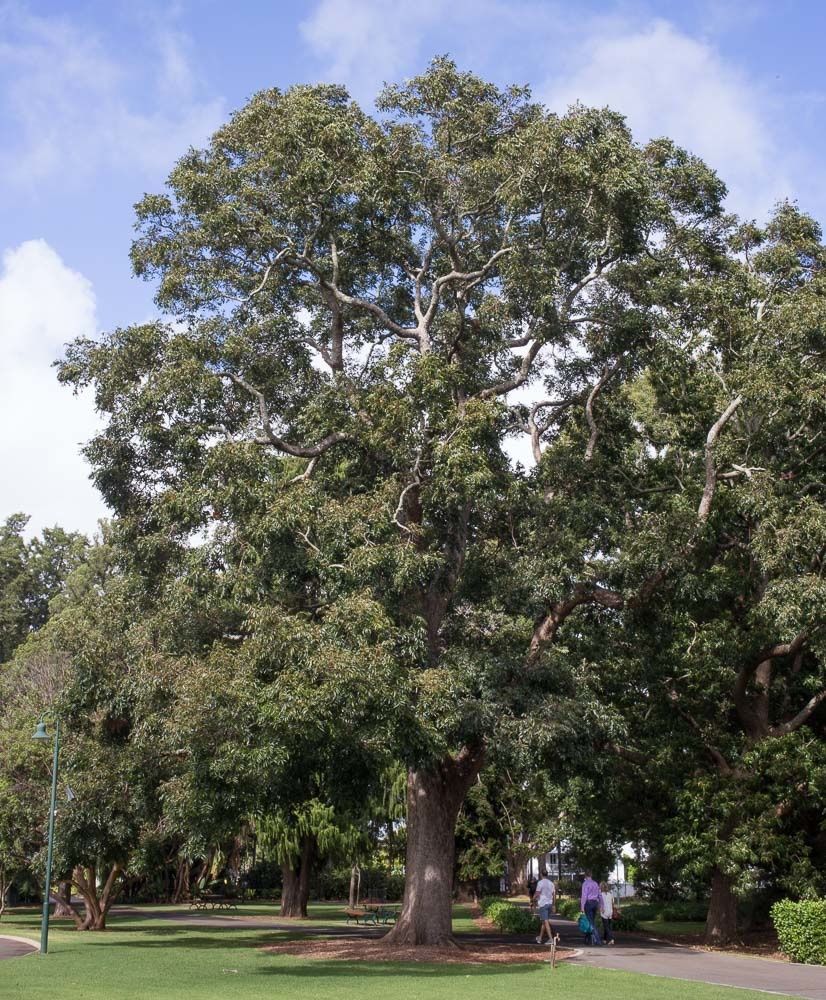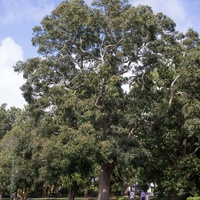Common name: Australian Red Cedar
Other common names: Australian Cedar, Australian Toon, Burma Cedar, Burma Toon, Harms Red Cedar, Indian Mahogany, Moulmein Cedar, Queensland Red Cedar, Red Cedar, Toon
Description
Australian Red Cedar or Tun is a timber and landscape tree with a wide distribution, its natural range extending over large parts of India into Bangladesh and from Southeast Asia through Papua New Guinea to eastern Australia.
It attains a height of up to 40 m (130 ft) in closely spaced forests, with buttressed roots up to 3 m (10 ft) tall. However, it is more typically 15 to 20 m (50 to 65 ft) tall without buttresses and a straight trunk. The bark is smooth, dark grey to reddish-brown, becoming rough, cracked and flaking with age.
The branches are gently ascending, forming a dense, rounded crown of feathery leaves, each up to 40 cm (16 in) long and consisting of many lance-shaped leaflets arranged in pairs along the length. They remain on the tree in the wettest parts of its range but are otherwise deciduous, falling in the dry season to conserve water. The new leaflets emerge after a brief period in crimson red, gradually changing to bronze, then green as they age.
The flowers are bisexual, small, whitish and sweetly fragrant. They bloom from spring to early summer in clusters at the ends of the branches and are followed by woody, pear-shaped seed capsules. When mature, the capsules split open into five segments, releasing winged seed that get carried on the wind.

Queens Park, Toowoomba, Australia
Use
Australian red cedar produces light- to medium-weight wood, in the 350 to 600 kilograms per cubic meter (22 to 37 lbs per cubic ft) range, with variable natural resistance to rot, decay and wood-boring insects. This variability can be explained, at least in part, by tree growth rates, with trees in the drier and cooler parts of its range tending to be slower growing than trees in the wetter and warmer parts. At its best, it is a dense, durable wood resistant to fungal and insect attack. The heartwood is fragrant and has a pinkish-red tone that darkens somewhat on exposure to air.
The sawn timber is used for musical instruments, furniture and cabinets, and interior joinery and millwork. Selected logs are sliced for decorative veneer.
The flowers produce reasonable amounts of nectar for honey production, with flows lasting for around two weeks. The honey yields are reportedly moderate. However, there does not appear to be any further information that would help to quantify this. The honey is described as having a light to white amber colour and pronounced flavour.
The five-parted, woody seed capsules have a flower shape, which has led to their use in dried floral arrangements, particularly in Hawaii.
Climate
Grows naturally and reaches its best development as a tree in humid subtropical and tropical climates, generally areas with annual lows of 10 to 23°C, annual highs of 22 to 35°C, annual rainfall of 700 to 4500 mm and a dry season of 7 months or less.
Growing
New plants are usually started from seed, which remain viable for around six months. Growth performance is best on deep, rich, free-draining loam and sand soils of an acid to neutral nature, generally with a pH of 5.0 to 7.0 and on sites with full to partial sun exposure.
Problem features
The seed are designed for dispersal by wind, which can carry them afar. It is reported as moderately invasive in South Africa and is assessed as a high weed risk species for Hawaii by the Hawaii Pacific Weed Risk Assessment (HPWRA) project.
Where it grows
References
Books
-
Barwick, M., et al. 2004, Tropical & subtropical trees : a worldwide encyclopaedic guide, Thames and Hudson, London
-
Boland, D. & Brooker, I. & McDonald, M. W. 2006, Forest trees of Australia, 5th ed., CSIRO Publishing (Ensis), Melbourne
-
Bonner, F. T & Karrfalt, R. P. 2008, The woody plant seed manual, U.S. Department of Agriculture, Forest Service, Washington D.C.
-
Bradbear, N. 2009, Bees and their role in forest livelihoods : a guide to the services provided by bees and the sustainable harvesting, processing and marketing of their products, Food and Agriculture Organization of the United Nations (FAO), Rome
-
Crane, E., Walker, P. & Day, R. 1984, Directory of important world honey sources, International Bee Research Association, London
-
Dastur, J. F. 1964, Useful plants of India and Pakistan : a popular handbook of trees and plants of industrial, economic, and commercial utility, 2nd ed., D. B. Taraporevala Sons, Bombay
-
Francis, J. K. 1998, Tree species for planting in forest, rural, and urban areas of Puerto Rico, U.S. Department of Agriculture, Forest Service, International Institute of Tropical Forestry, Río Piedras, Puerto Rico
-
Holliday, I. 2002, A field guide to Australian trees, 3rd revised editon, New Holland Publishers, Frenchs Forest, New South Wales
-
Howes, F. N. 1949, Vegetable gums and resins, Chronica Botanica Company, Waltham, Massachusetts
-
Krishen, P. 2006, Trees of Delhi : a field guide, Dorling Kindersley Publishers, Delhi
-
Letourneux, C. 1957, Tree planting practices in tropical Asia, Food and Agriculture Organization of the United Nations (FAO), Rome
-
Liegel, L. H. 1987. A technical guide for forest nursery management in the Caribbean and Latin America, U.S. Dept. of Agriculture, Forest Service, Southern Forest Experiment Station, New Orleans
-
Little, E. L. & Skolmen, R. G. 1989, Common forest trees of Hawaii (native and introduced), Agricultuural Handbook No. 679, Forest Service, U.S. Department of Agriculture, Washington, D.C.
-
Little, E. L. et al. 1964 and 1974, Common trees of Puerto Rico and the Virgin Islands (2 volumes), Forest Service, U.S. Department of Agriculture (USDA), Washington D.C.
-
Luna, R. K 1996, Plantation trees, International Book Distributors, Dehradun, Uttarakhand
-
Macmillan, H. F. 1943, Tropical planting and gardening : with special reference to Ceylon, 5th ed, Macmillan Publishing, London
-
Parrotta, J. A. 2001, Healing plants of peninsular India, CABI Publishing, Wallingford, Oxfordshire
-
Porter, T. 2012, Wood : identification & use, Compact edition, Guild of Master Craftsman Publications, Lewes, East Sussex
-
Randall, R. P. 2002, A global compendium of weeds, R.G. and F.J. Richardson Press, Melbourne
-
Reyes, G. 1992, Wood densities of tropical tree species, U.S. Department of Agriculture, Forest Service, Southern Forest Experiment Station, New Orleans, Louisiana
-
Scheffer, T. C & Morrell, J. J. 1998, Natural durability of wood : a worldwide checklist of species, Forest Research Laboratory, Oregon State University, Corvallis, Oregon
-
Sheikh M. I. 1993, Trees of Pakistan, USAID Forestry Planning and Development Project, Pictorial Printers, Islamabad
-
Singh, R. V. 1982, Fodder trees of India, Oxford & IBH Publishing Company, New Delhi
-
Streets, R. J. & Troup, R. S. 1962, Exotic forest trees in the British Commonwealth, Oxford University Press, Oxford, England
-
Troup, R.S. & Joshi, H. B. 1975 to 1981, Silviculture of Indian Trees (3 volumes), Government of India Publications, New Delhi
-
Webb, D. B. 1984, A Guide to species selection for tropical and sub-tropical plantations, 2nd ed., Unit of Tropical Silviculture, Commonwealth Forestry Institute, University of Oxford, Oxfordshire
Articles, Journals, Reports and Working Papers
-
Singh, K. P. & Kushwaha, C. P. 2006, Diversity of flowering and fruiting phenology of trees in a tropical deciduous forest in India, Oxford University Press
-
Skolmen R.G. 2000, Some woods of Hawaii: properties and uses of 16 commercial species, University of Hawaii, Honolulu, (Resource Managment; RM-7), 33 p.


